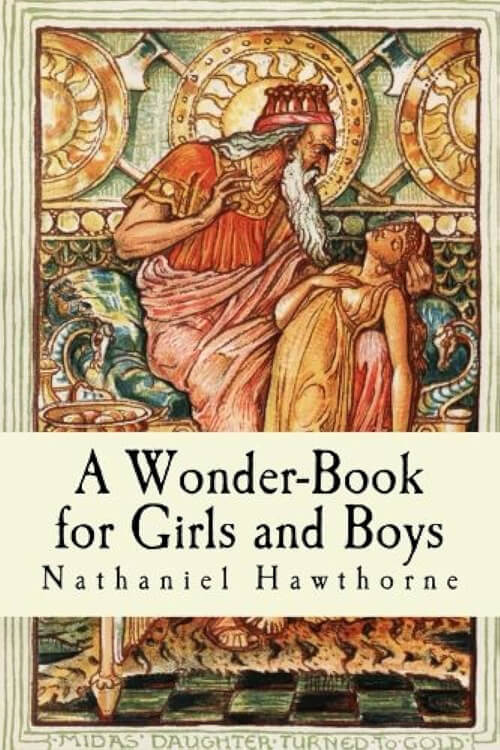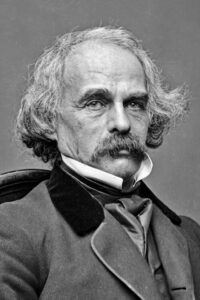
A Wonder Book for Girls & Boys
This body of white vapor extended to within less than a hundred yards of the house. It completely hid everything beyond that distance, except a few ruddy or yellow tree-tops, which here and there emerged, and were glorified by the early sunshine, as was likewise the broad surface of the mist. Four or five miles off to the southward rose the summit of Monument Mountain, and seemed to be floating on a cloud. Some fifteen miles farther away, in the same direction, appeared the loftier Dome of Taconic, looking blue and indistinct, and hardly so substantial as the vapory sea that almost rolled over it. The nearer hills, which bordered the valley, were half submerged and were specked with little cloud wreaths to their tops. On the whole, there was so much cloud, and so little solid earth, that it had the effect of a vision.
The children above-mentioned, being as full of life as they could hold, kept overflowing from the porch of Tanglewood, and scampering along the gravel-walk, or rushing across the dewy herbage of the lawn. I can hardly tell how many of these small people there were; not less than nine or ten, however, nor more than a dozen, of all sorts, sizes, and ages, whether girls or boys. They were brothers, sisters, and cousins, together with a few of their young acquaintances, who had been invited by Mr. and Mrs. Pringle to spend some of this delightful weather with their children at Tanglewood. I am afraid to tell you their names, or even to give them any names which other children have ever been called by; because, to my certain knowledge, authors sometimes get themselves into great trouble by accidentally giving the names of real persons to the characters in their books. For this reason, I mean to call them Primrose, Periwinkle, Sweet Fern, Dandelion, Blue Eye, Clover, Huckleberry, Cowslip, Squash-Blossom, Milkweed, Plantain, and Buttercup; although, to be sure, such titles might better suit a group of fairies than a company of earthly children.
It is not to be supposed that these little folks were to be permitted by their careful fathers and mothers, uncles, aunts, or grandparents, to stray abroad into the woods and fields, without the guardianship of some particularly grave and elderly person. Oh, no, indeed! In the first sentence of my book, you will recollect that I spoke of a tall youth, standing amid the children. His name—(and I shall let you know his real name because he considers it a great honor to have told the stories that are here to be printed)—his name was Eustace Bright. He was a student at Williams College, and had reached, I think, at this period, the venerable age of eighteen years; so that he felt quite like a grandfather towards Periwinkle, Dandelion, Huckleberry, Squash-Blossom, Milkweed, and the rest, who were only half or a third as venerable as he.
Read or download Book
Nathaniel Hawthorne
Nathaniel Hawthorne (born Nathaniel Hathorne; July 4, 1804 – May 19, 1864) was an American novelist and short story writer. His works often focus on history, morality, and religion.
He was born in 1804 in Salem, Massachusetts, to a family long associated with that town. Hawthorne entered Bowdoin College in 1821, was elected to Phi Beta Kappa in 1824, and graduated in 1825. He published his first work in 1828, the novel Fanshawe; he later tried to suppress it, feeling that it was not equal to the standard of his later work. He published several short stories in periodicals, which he collected in 1837 as Twice-Told Tales. The following year, he became engaged to Sophia Peabody. He worked at the Boston Custom House and joined Brook Farm, a transcendentalist community, before marrying Peabody in 1842. The couple moved to The Old Manse in Concord, Massachusetts, later moving to Salem, the Berkshires, and then to The Wayside in Concord. The Scarlet Letter was published in 1850, followed by a succession of other novels. A political appointment as consul took Hawthorne and their family to Europe before their return to Concord in 1860. Hawthorne died on May 19, 1864.
Much of Hawthorne’s writing centers on New England, many works featuring moral metaphors with an anti-Puritan inspiration. His fiction works are considered part of the Romantic movement and, more specifically, dark romanticism. His themes often center on the inherent evil and sin of humanity, and his works often have moral messages and deep psychological complexity. His published works include novels, short stories, and a biography of his college friend Franklin Pierce, written for his 1852 campaign for President of the United States, which Pierce won, becoming the 14th president.
Biography
Early life
Nathaniel Hathorne, as his name was originally spelled, was born on July 4, 1804, in Salem, Massachusetts; his birthplace is preserved and open to the public. His great-great-great-grandfather, William Hathorne, was a Puritan and the first of the family to emigrate from England. He settled in Dorchester, Massachusetts, before moving to Salem. There he became an important member of the Massachusetts Bay Colony and held many political positions, including magistrate and judge, becoming infamous for his harsh sentencing. William’s son, Hawthorne’s great-great-grandfather, John Hathorne was one of the judges who oversaw the Salem witch trials. Hawthorne probably added the “w” to his surname in his early twenties, shortly after graduating from college, to dissociate himself from his notorious forebears. Hawthorne’s father Nathaniel Hathorne Sr. was a sea captain who died in 1808 of yellow fever in Dutch Suriname; he had been a member of the East India Marine Society. After his death, his widow moved with young Nathaniel, his older sister Elizabeth, and their younger sister Louisa to live with relatives named the Mannings in Salem, where they lived for 10 years. Young Hawthorne was hit on the leg while playing “bat and ball” on November 10, 1813, and he became lame and bedridden for a year, though several physicians could find nothing wrong with him.
In the summer of 1816, the family lived as boarders with farmers before moving to a home recently built specifically for them by Hawthorne’s uncles Richard and Robert Manning in Raymond, Maine, near Sebago Lake. Years later, Hawthorne looked back at his time in Maine fondly: “Those were delightful days, for that part of the country was wild then, with only scattered clearings, and nine-tenths of it primeval woods.” In 1819, he was sent back to Salem for school and soon complained of homesickness and being too far from his mother and sisters. He distributed seven issues of The Spectator to his family in August and September 1820 for fun. The homemade newspaper was written by hand and included essays, poems, and news featuring the young author’s adolescent humor.
Hawthorne’s uncle Robert Manning insisted that the boy attend college, despite Hawthorne’s protests. With the financial support of his uncle, Hawthorne was sent to Bowdoin College in 1821, partly because of family connections in the area, and also because of its relatively inexpensive tuition rate. Hawthorne met future president Franklin Pierce on the way to Bowdoin, at the stage stop in Portland, and the two became fast friends. Once at the school, he also met future poet Henry Wadsworth Longfellow, future congressman Jonathan Cilley, and future naval reformer Horatio Bridge.






